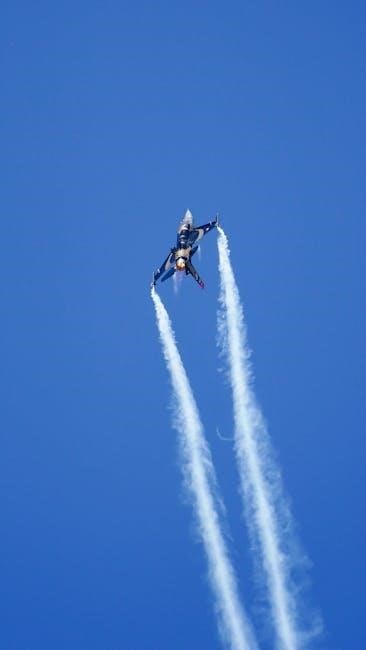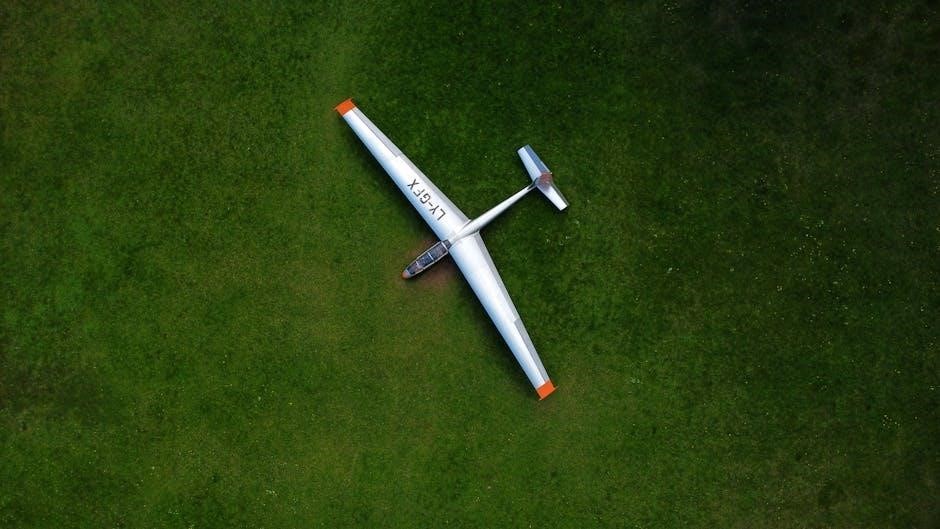The V-n diagram is a graphical representation of an aircraft’s load factor versus airspeed, providing operational and structural limits to ensure safe flight maneuvers and performance.
1.1 Definition and Purpose
The V-n diagram, or velocity-load factor diagram, graphically illustrates the relationship between an aircraft’s airspeed (V) and load factor (n). It defines the operational envelope within which the aircraft must fly to ensure structural integrity and safe performance. The diagram plots load factor limits against airspeed, showing the maximum permissible loads during various flight regimes. Its primary purpose is to provide pilots with clear boundaries for safe operations, preventing structural damage from excessive loads. This tool is essential for understanding an aircraft’s flight envelope and ensuring adherence to design and operational constraints.
1.2 Importance in Aircraft Design and Operations
The V-n diagram is critical in aircraft design and operations as it establishes the safe operational envelope, ensuring structural integrity during various flight maneuvers. Designers use it to determine load limits, while pilots rely on it to avoid exceeding safe airspeed and load factor combinations. This diagram is essential for preventing structural damage, optimizing performance, and maintaining safety margins. By defining the aircraft’s flight envelope, it bridges design specifications with real-world operational constraints, making it indispensable for both manufacturers and operators.
Key Components of the V-n Diagram
The V-n diagram includes load factor (n), airspeed (V), stall speed (Vs), maneuvering speed (Va), cruise speed (Vc), and dive speed (Vd), defining the aircraft’s operational limits.
2.1 Load Factor (n)
The load factor (n) represents the ratio of lift to weight (L/W) and is a critical component of the V-n diagram. In level flight, n equals 1, but during maneuvers, it increases, requiring the aircraft’s structure to withstand these forces. The V-n diagram is primarily concerned with symmetric maneuvers in the vertical plane, as the vertical load factor (Nz) has the highest impact. Other load factors (Nx, Ny) remain constant and are less critical for structural integrity. This focus ensures the aircraft operates safely within its design limits, preventing structural damage during various flight conditions.
2.2 Airspeed (V)
Airspeed (V) is plotted on the horizontal axis of the V-n diagram and represents the aircraft’s velocity during various flight conditions. It is a critical parameter for determining the aircraft’s operational limits, as it directly influences the load factor (n). Key reference airspeeds, such as stall speed (Vs), design maneuvering speed (Va), design cruise speed (Vc), and design dive speed (Vd), are marked on the diagram. These speeds define the boundaries within which the aircraft can safely operate, ensuring structural integrity and performance under different flight regimes and load factors.
2.3 Stall Speed (Vs)
Stall speed (Vs) is the minimum airspeed at which an aircraft can generate enough lift to remain airborne. It is a fundamental parameter on the V-n diagram, marking the boundary between normal flight and stall conditions. The stall speed varies with aircraft weight and configuration, and it is typically higher at higher load factors. Exceeding the stall speed ensures controlled flight, while falling below it leads to a loss of lift and potential stalling. Accurate knowledge of Vs is crucial for safe operation, as it determines the lower limit of the flight envelope and influences maneuvering capabilities.
2.4 Design Maneuvering Speed (Va)
Design maneuvering speed (Va) is the maximum airspeed at which an aircraft can be safely subjected to full control deflections without risking structural damage. It is a critical parameter on the V-n diagram, representing the boundary between gentle and aggressive flight maneuvers. Va is typically higher than the stall speed (Vs) and lower than the design cruise speed (Vc). It is determined by the aircraft’s structural strength and serves as a guideline for pilots to avoid exceeding safe load factors during sharp turns or abrupt control inputs, ensuring the aircraft remains within its structural limits.
2.5 Design Cruise Speed (Vc)
Design cruise speed (Vc) represents the airspeed at which an aircraft is designed to operate efficiently during cruising flight. It is typically higher than the design maneuvering speed (Va) and falls within the structural limits defined by the V-n diagram. Vc is determined based on the aircraft’s aerodynamic efficiency and structural integrity, ensuring optimal performance and fuel economy. Exceeding Vc may lead to reduced efficiency or potential structural stress, making it a critical reference point for pilots to maintain during long-range or high-altitude flights, balancing performance and safety.
2.6 Design Dive Speed (Vd)
Design dive speed (Vd) is the maximum airspeed at which an aircraft is designed to withstand the structural loads generated during a dive. It represents the highest speed for safe diving operations, beyond which the aircraft may experience structural damage. Vd is typically higher than the design cruise speed (Vc) and is determined by the aircraft’s ability to handle the stresses of high-speed descents. Pilots must adhere to this limit to ensure the integrity of the airframe and maintain safe flight operations, as exceeding Vd could lead to catastrophic failure of structural components.

Load Factor Limits
Load factor limits define the maximum positive and negative load factors an aircraft can withstand during maneuvers, ensuring structural integrity and safe flight operations.
3.1 Positive Load Factor
The positive load factor represents the maximum upward force an aircraft can sustain during climbs or turns without risking structural damage. It is expressed as a multiple of the aircraft’s weight and varies with airspeed, typically highest at lower speeds. Exceeding this limit can lead to overstressing the airframe, potentially causing failure. The V-n diagram visually caps the positive load factor at a specific airspeed, ensuring pilots operate within safe boundaries. This limit is crucial for maintaining structural integrity during aggressive maneuvers or turbulence encounters.

3.2 Negative Load Factor
The negative load factor indicates the maximum downward force an aircraft can withstand during inverted flight or aggressive pushovers. It is generally lower than the positive load factor, as aircraft structures are optimized for upward forces. Exceeding the negative load factor can lead to loss of control or structural damage. The V-n diagram clearly delineates this limit, typically at lower airspeeds, ensuring pilots avoid maneuvers that could compromise safety. Adhering to this boundary is essential for maintaining aircraft integrity and preventing potentially catastrophic failures during negative-G conditions.
3.3 Gust Load Factors
Gust load factors represent the maximum forces an aircraft can endure due to sudden wind gusts or turbulence. These factors vary by aircraft type and altitude, as specified by airworthiness authorities. The V-n diagram incorporates gust load limits to ensure structural integrity during unexpected conditions. Exceeding these limits can lead to overstressing of the airframe. Pilots must adhere to these boundaries to maintain safety, especially in turbulent environments. Gust load factors are critical for assessing an aircraft’s ability to withstand environmental stresses without compromising its structural integrity or performance.

Constructing the V-n Diagram
Constructing the V-n diagram involves plotting the stall curve, adding structural load limits, and determining the corner point to define the aircraft’s flight envelope and safe operating boundaries.
4.1 Plotting the Stall Curve
Plotting the stall curve involves determining the aircraft’s stall speed (Vs) at various load factors (n). The stall curve is typically parabolic, with Vs increasing as the load factor rises. At 1g (level flight), Vs is the baseline stall speed. As load factors increase (positive or negative), the stall speed increases due to the higher angle of attack required. This curve defines the boundary between stalled and unstalled flight, ensuring pilots understand the aircraft’s performance limits. Accurate plotting is critical for determining safe operating envelopes and preventing stall-related incidents during maneuvers.
4.2 Adding Structural Load Limits
Structural load limits are added to the V-n diagram to represent the maximum allowable load factors (n) the aircraft can withstand at various airspeeds (V). These limits are determined by the aircraft’s design strength and materials. The positive and negative load factor boundaries are plotted as horizontal lines, intersecting the stall curve at the corner point. Gust load factors, which consider atmospheric turbulence, are also included. These limits ensure the aircraft operates within its structural integrity, preventing damage during maneuvers. Pilots must adhere to these boundaries to maintain safety and performance.
4.3 Determining the Corner Point
The corner point on the V-n diagram is the intersection of the stall curve and the structural load limits. It represents the airspeed where the aircraft transitions from being stall-limited to being structurally limited. Below this speed, maneuvers are constrained by stall characteristics, while above it, structural limits govern. To find this point, the stall curve and load limits are plotted, and their intersection is identified. This point is crucial for pilots, as it defines the boundary between stall and structural limitations, ensuring safe operation within the aircraft’s performance envelope.

Factors Affecting the V-n Diagram
Aircraft weight, altitude, and configuration significantly influence the V-n diagram, altering structural limits and flight envelope boundaries to ensure safe operational parameters are maintained during flight.
5.1 Aircraft Weight
Aircraft weight directly impacts the V-n diagram by influencing the stall speed and load factor limits. As weight increases, the stall speed rises, and the maximum positive and negative load factors decrease. This adjustment ensures the aircraft remains within structural limits during maneuvers. The flight envelope narrows at higher weights, restricting operational flexibility. Designers account for weight variations to maintain safety margins, while pilots must adjust their flying techniques to stay within the revised limits, ensuring the aircraft’s structural integrity is preserved under all operational conditions.
5.2 Altitude
Altitude significantly influences the V-n diagram by affecting air density, which alters the aircraft’s performance characteristics. As altitude increases, the stall speed rises due to lower air density, while the maximum load factors decrease. This narrowing of the flight envelope at higher altitudes reduces the aircraft’s ability to withstand gusts and perform aggressive maneuvers safely. Pilots must adjust their flying techniques to stay within the revised limits, ensuring structural integrity and safe operation under varying atmospheric conditions. Altitude corrections are critical for maintaining the aircraft’s performance envelope and ensuring compliance with design limitations.
5.3 Aircraft Configuration
Aircraft configuration significantly impacts the V-n diagram by altering aerodynamic characteristics and structural limits; Extensions such as flaps, slats, and landing gear modify the stall speed and load factor capabilities. For instance, landing gear deployment increases drag, reducing maximum airspeed, while flap extensions lower stall speed but restrict maneuvering limits. Weight distribution and center of gravity changes also affect the diagram, requiring adjustments to ensure safe operation within the revised envelope. Each configuration demands a unique V-n analysis to maintain performance and structural integrity, ensuring pilots operate safely within the aircraft’s design constraints.
Reading and Interpreting the V-n Diagram
The V-n diagram displays an aircraft’s speed and load factor limits, showing the flight envelope and safe operating boundaries. It helps pilots understand permissible maneuvers and speeds.
6.1 Understanding the Flight Envelope
The flight envelope, depicted on the V-n diagram, represents the boundary of safe aircraft operations. It illustrates the maximum and minimum airspeeds and load factors an aircraft can withstand. The envelope is defined by the stall curve, structural load limits, and design speeds. Pilots must operate within this boundary to ensure safety and prevent structural damage. The envelope varies with factors like aircraft weight, altitude, and configuration, making it essential for pilots to understand these limits for safe maneuvering and performance.

6.2 Identifying Safe Operating Limits
The V-n diagram helps pilots identify safe operating limits by clearly defining the maximum and minimum load factors at various airspeeds. Key markers include the stall speed (Vs), design maneuvering speed (Va), design cruise speed (Vc), and design dive speed (Vd). Load factors, both positive and negative, are also plotted to show structural limits. Gust load factors are highlighted to account for turbulence effects. By staying within these boundaries, pilots ensure the aircraft operates safely, avoiding structural damage and maintaining controlled flight. These limits are critical for all flight phases, from takeoff to landing.
The V-n diagram is an essential tool for ensuring aircraft safety and performance. By defining the relationship between load factor and airspeed, it provides clear operational boundaries. Pilots and designers rely on it to understand structural limits, avoid unsafe conditions, and optimize flight maneuvers. The diagram’s interpretation is critical for training and decision-making, ensuring compliance with airworthiness standards. Ultimately, the V-n diagram serves as a comprehensive guide to maintaining aircraft integrity and achieving efficient, secure flight operations across all conditions.




